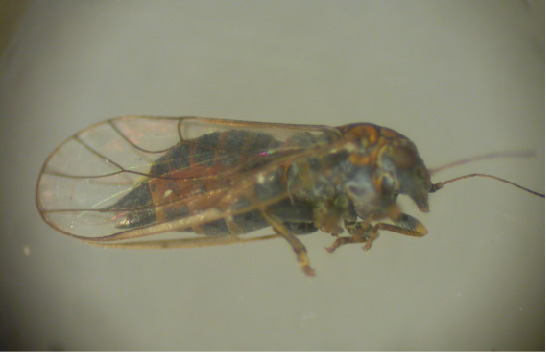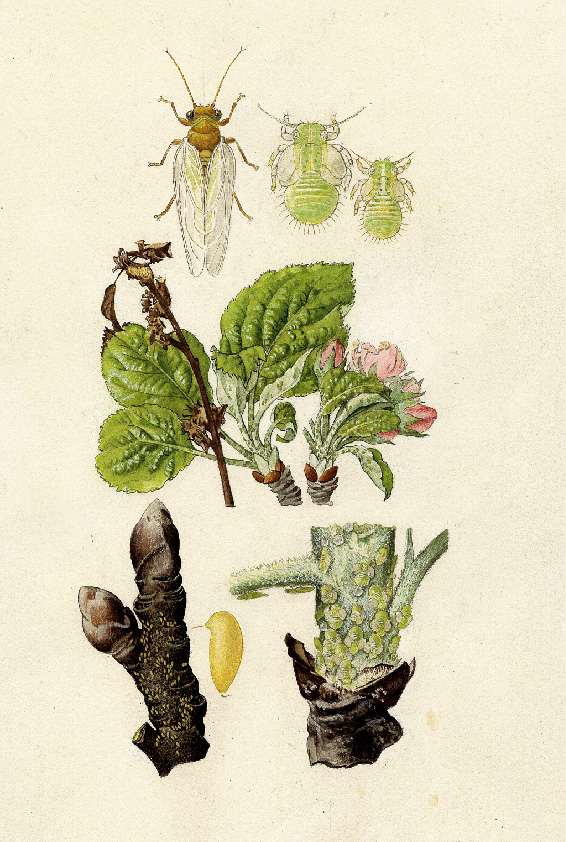Apple leaf sucker
Cacopsylla sp.
Appearance

Apple leaf suckers belong to the plant lice (Sternorrhyncha) within the order Beak bugs (Hemiptera), where they are representatives of the family Leaf suckers (Psyllidae).
There are three apple leaf sucker species:
- Summer apple leaf sucker(Cacopsylla picta).
- Spring apple leaf sucker(Cacopsylla mali)
- Hawthorn leaf sucker (brown pear leaf sucker)(Cacopsylla melanoneura)
Apple leaf suckers are insects about two to four millimeters in size with a proboscis and four membranous wings, which they have laid out in a roof shape when at rest. Since they can also jump excellently, they are also called leaf fleas. The adults of the new generation (in summer) are greenish in color, only later (towards autumn or in winter and spring) they become darker and are brownish.
The larvae have flattened bodies, are initially light green to yellowish in color, later orange to dark brown, and have a scale-like appearance. Small wing scales are visible in the older larval stages.
Biology
The adult summer apple leaf sucker and hawthorn leaf sucker overwinter on conifers and return to apple trees in early spring. The hawthorn leaf sucker is found very early, starting around February, while the summer apple leaf sucker is not found until March/April. Unlike these two species, the overwintering of the spring apple leaf sucker occurs in the egg stage directly on apple trees.
Adult summer apple leaf suckers and hawthorn leaf suckers suck young leaves and begin laying eggs on flower and leaf petioles and undersides of leaves at flowering time. The hatched larvae, also called nymphs, suck on young shoots, leaves, buds, and young fruits. Larvae are found in all three species during April and May. The winged adult stages emerge from May through June and July before migrating back to their overwintering sites - except for the spring leaf sucker, which is present longer into the summer, laying its eggs beginning in late August and can be found through September. This one does not make a host switch.
The next year, immigration of overwintering individuals of summer apple leaf sucker and hawthorn leaf sucker occurs again at the beginning of budbreak.
All three species occur with one generation per year.
Damage symptoms
The adult leaf suckers and the larvae feed on plant sap from the phloem of the plants. As a result of sucking, the leaf and flower clusters develop slowly in spring, become brownish in colour and can also die in the case of heavy infestation. In addition, the adult leaf suckers and especially the larvae produce sugary, sticky excretions (honeydew) on the leaves and shoots, which serve as a breeding ground for sooty mould fungi. As a result, blackish spots can be found as secondary damage.
Economic significance
Due to the sucking activity of the apple leaf sucker, blossoms, leaves and young shoots wilt, partially unfold with delay, turn brown and can also die and fall off. Therefore, in the case of heavy infestation, fruit set can also be significantly impaired. The sooty moulds caused by the honeydew of the leaf suckers cause additional damage and reduce the quality of the fruit.
The apple leaf sucker is of great importance as a vector of 'Candidatus Phytoplasma mali', the causal agent of apple proliferation disease. The summer apple leaf sucker is the most important vector of this phytoplasmosis in Germany and neighbouring countries, while the hawthorn leaf sucker has only been found as a vector in certain areas (e.g. NW Italy). The spring apple leaf sucker is not yet known to be a vector of the pathogen. In Austria, no apple leaf sucker infected with'Candidatus Phytoplasma mali' has been detected so far.
Prevention and control
- During the winter dormancy and growing season, tapping samples provide information on the presence of leaf suckers; after budbreak, leaves can be examined for eggs and hatched larvae (visual inspection).
- Shoot treatments with kerosene oil can kill some of the overwintering animals or eggs on trunks and branches.
- Cut off and destroy severely damaged shoots
- Approved plant protection products for protection against apple leaf sucker can be found in the list of plant protection products approved in Austria . Since honeydew protects them, it is beneficial to apply treatments with high pressure and increased spray application rates or after heavy rains (honeydew is partially washed away by rain). Early treatments prevent damage in summer. Care should also be taken to protect the natural enemies of the leaf suckers.
- The most important natural enemies of apple leaf suckers are flower bugs (Anthocoridae), spiders, ladybugs, earwigs, lacewings, and tiger wasps. The use of plant protection products that are gentle on beneficial insects and the maintenance of adjacent herbaceous strips and hedges rich in species and structure specifically promote them.
Specialized information
Publications
Lethmayer, C., Hausdorf, H., Suarez-Mahecha, B., Reisenzein, H., 2011. The importance of psyllids (Hemiptera: Psyllidae) as vectors of phytoplasmas in pome and stone fruit trees in Austria. Bulletin of Insectology, 64, 255-256.
Our monitoring activities
In 2009 and 2010 we collected Psyllidae in apple orchards in Lower Austria.
Projects
EU-ERANET EUPHRESCO-II project APOPHYT: "Evaluation of factors determining distribution, impact, detection and characterization of fruit tree phytoplasmoses", 01.09.2012 - 31.08.2014, project partner
BIOLURE project: "Control of insects with olfactory attractants and repellents. Development of innovative attractant traps for monitoring and mass trapping of vectors of fruit tree phytoplasmoses", 01.01.2012 - 31.08.2014; project partner.
Last updated: 10.07.2025
automatically translated
